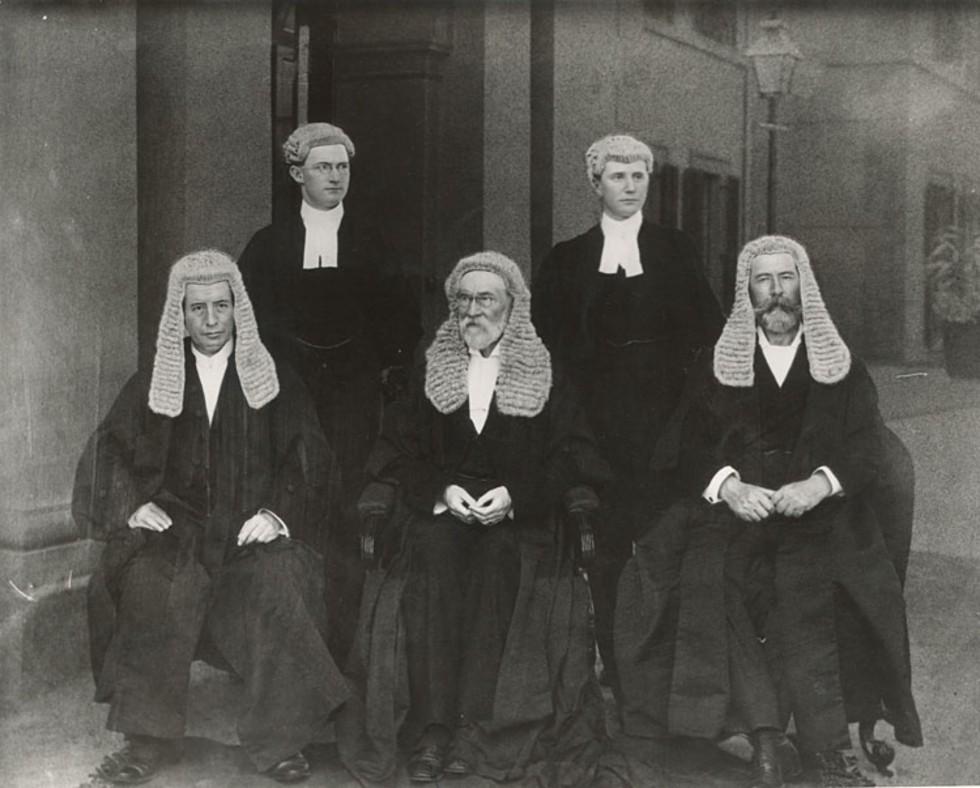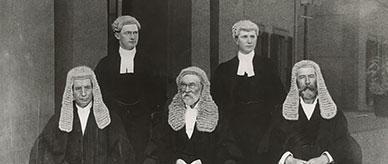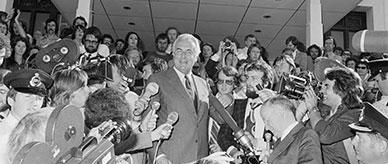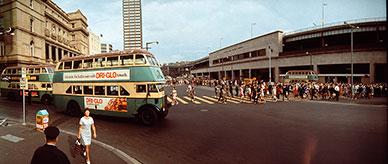


About this record
This black-and-white photograph shows the three original judges of the High Court of Australia, with two court officials standing behind them. Seated from left to right are Justice Sir Edmund Barton, Chief Justice Sir Samuel Griffith and Justice Richard O'Connor. The photograph was taken outside the Supreme Court of Victoria at the first sitting of the High Court on 6 October 1903.
Educational value
- This photograph represents a significant stage in the establishment of the High Court – the appointment of its first Bench. Section 71 of the Constitution provided for the court and states: 'The judicial power of the Commonwealth shall be vested in a Federal Supreme Court', but the High Court could not begin to fulfil its dual functions of being Australia's final court of appeal and its constitutional court until the judges seen here had been appointed.
- The fact that only three judges were appointed by the federal government under the terms of the Judiciary Act 1903 – instead of the five initially advocated by the first Attorney-General, Alfred Deakin (1856–1919) – reflected opinion at the time that the High Court was redundant and that five expensive justices would have little to do. In fact, the court's workload quickly became too much for three judges and in 1906 two more judges were appointed.
- Under the leadership of Chief Justice Sir Samuel Griffith (1845–1920), the judgements of the generally unanimous Bench have influenced the court's approach to federal jurisdiction ever since, firmly establishing the principle of the separation of powers of the executive, legislature and judiciary. Griffith, a former Premier of Queensland, had a major role in preparing an early draft of the Constitution and was international expert in federal law.
- The Senior Puisne (lower ranked) Judge of the High Court, Sir Edmund Barton (1849–1920), had resigned as Prime Minister in order to join the court in 1903 and rather unexpectedly proved to be a sound judge, particularly in the court's appellate jurisdiction. Although he was trained in the law, Barton's fame rests more on his role as the indefatigable champion and leader of the Australian federation movement and as Australia's first prime minister than as a judge.
- Richard O'Connor (1851–1912), a former minister of justice in New South Wales and leader of the government in the Senate, established a paramount principle of constitutional interpretation that is still applied by the High Court today. A close friend of Barton and a fellow cricket enthusiast, O'Connor argued for a broad rather than legalistic interpretation of the Constitution, recognising that it was meant to last and would need to be applied in changing circumstances.
- From 1903 the judgements of these original judges established the authority of the High Court in appellate jurisdiction over the state supreme courts, and in constitutional interpretation over the Australian parliament. At a more trivial level they upheld its authority in a long dispute with the Commonwealth Attorney-General over circuit sittings and travelling expenses. The dispute dragged on from 1904 to 1905 and led to a judges' 'strike' – a sitting being cancelled without due notice – in 1905.
Acknowledgments
Learning resource text © Education Services Australia Limited and the National Archives of Australia 2010.
Related themes
Need help with your research?
Learn how to interpret primary sources, use our collection and more.



